Neck Coupling Strength in MMA: Testing what matters
Available in:
EN
About the Author
Gavin Pratt is the Senior Director of Strength and Conditioning at the UFC Performance Institute, overseeing global performance programs for elite mixed martial artists.
With experience leading teams in Las Vegas, Shanghai and Mexico City, he focuses on systemized, athlete-centered approaches to assessment, program design and performance. He holds a Master’s in Exercise Science and is an ASCA Elite Level 3 Coach and EXOS Performance Specialist.
In a sport where impacts are inevitable and injury risk is high, strength and conditioning practitioners are constantly looking for ways to better prepare athletes for the demands of competition. In the Ultimate Fighting Championship (UFC), we have narrowed our attention to a region that is often underassessed but critically important: the neck.
Whether it is sustaining impact forces of a strike, completing takedowns or resisting a clinch, the neck coupling strength mechanism (trunk-neck-head) plays a key role in both performance and protection. At the UFC Performance Institute, our strength and conditioning staff have made neck strength assessment via fixed-frame dynamometry (e.g., ForceFrame) a core part of our holistic athlete profiling process.
The Importance of Neck Strength
Brain health and concussion risk are front of mind across many sports, especially in mixed martial arts (MMA), where the incidence of head impacts is often significantly higher. Although limited scientific evidence links neck coupling strength directly to reduced concussion risk, it is theoretically supported as a factor that may limit head acceleration under moderate to low force conditions.
In turn, neck coupling strength may have the potential to mitigate the risk associated with sports-related concussion (SRC).
…neck coupling strength may have the potential to mitigate the risk associated with SRC.
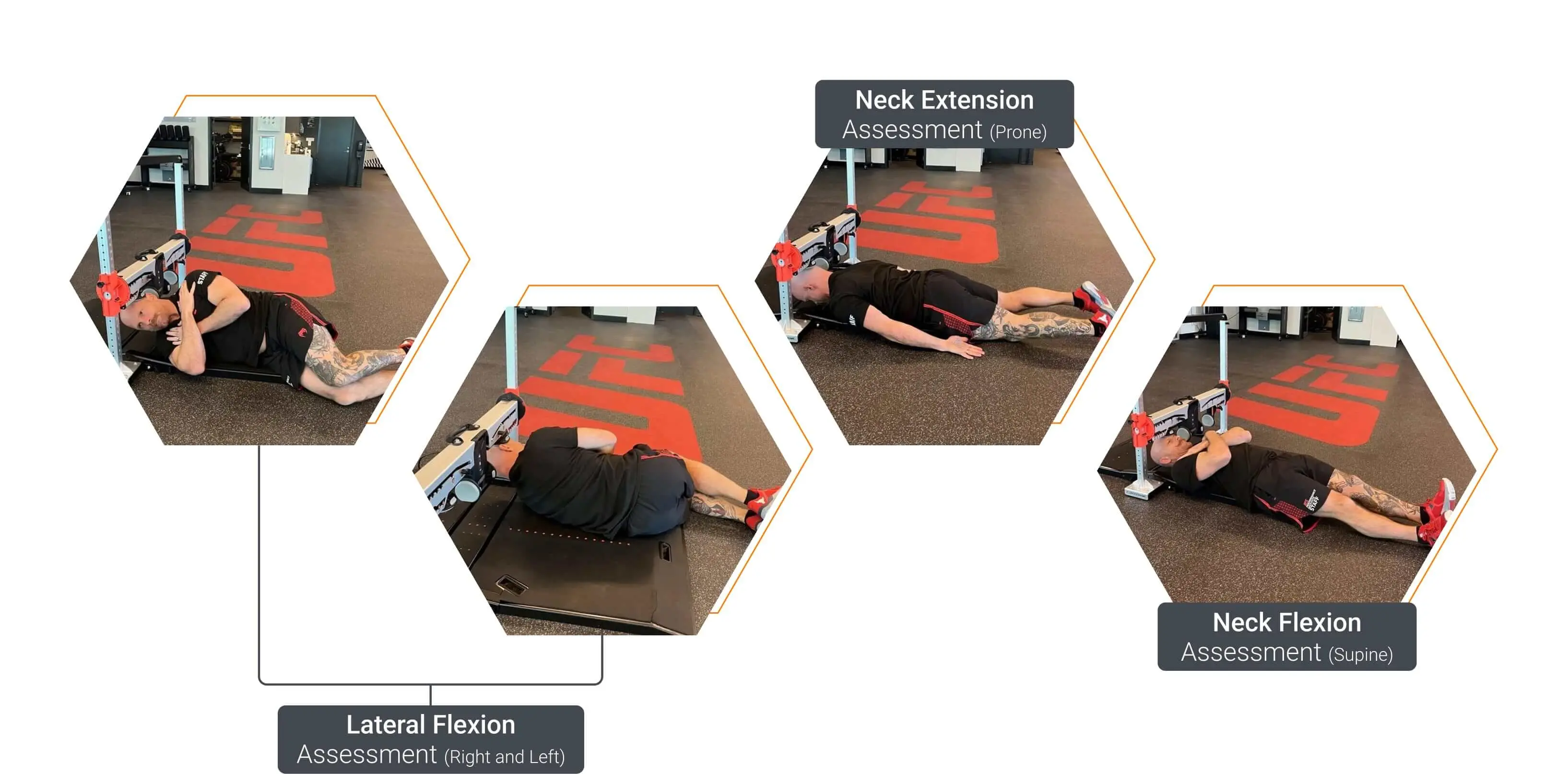
Neck coupling strength assessments using ForceFrame Fold.
Cervical injuries are also common in MMA, especially during grappling and wrestling exchanges. Improving neck strength helps protect and stabilize a vulnerable area that, when injured, often leads to significant time lost from training.
Neck strength also provides a competitive advantage, as the neck can be utilized as a first-class lever to provide greater leverage during takedown attempts.
…the neck can [also] be utilized as a first-class lever to provide greater leverage during takedown attempts…
Strengthening the neck contributes to greater resilience and improved stability of the cervical spine, which controls head movement. By assessing and training this quality, practitioners can improve athlete performance and potentially lower concussion risk.
Testing the System, Not Just the Muscle
True evaluation of cervical joint kinetics presents a very challenging proposition. Instead, what we are really assessing is not isolated neck strength – it is the coupling mechanism between the head, neck and trunk. This approach represents a proxy of athletic neck strength properties.
Through electromyography (EMG) exploration, we have seen the erector spinae activate at approximately 80% maximal voluntary contraction during a ForceFrame neck extension test. Therefore, we refer to this diagnostic approach as the “Neck Coupling Strength Test (NCST)” rather than an isolated neck isometric push.
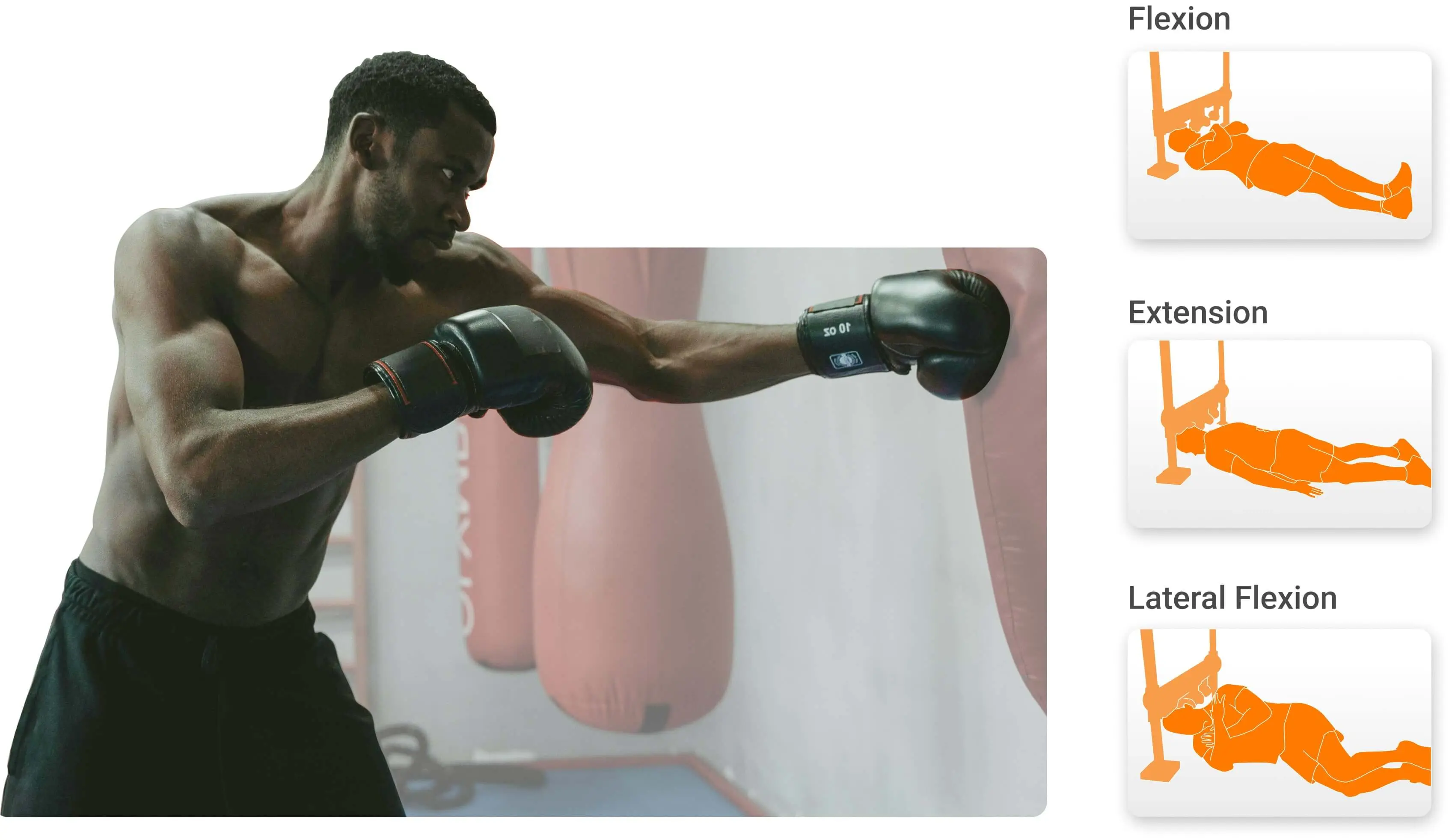
Athlete training for combat sports demonstrating the need for integrated neck coupling strength assessments.
Choosing the Right Tool
Reliable data starts with reliable tools, and ForceFrame has quickly become the go-to system for the NCST for several reasons:
- Fixed-frame setup eliminates variability from practitioner technique or strength.
- Supine, prone and side-lying positions reduce body compensation and standardize posture across a variable athlete cohort.
- Consistent cueing and setup on ForceFrame, with paddle and crossbar positions noted during each test, make setup for retesting seamless and reliable.
This matters, particularly with UFC athletes, who have the potential to express high force outputs – far beyond those of many athletes from traditional sports. ForceFrame’s high-load capacity handles that scale and provides consistent, reproducible data.
The NCST
We assess isometric strength for three muscle actions:
| Test | Body Orientation | Testing Overview | Visual |
| Neck Flexion | Supine |
| 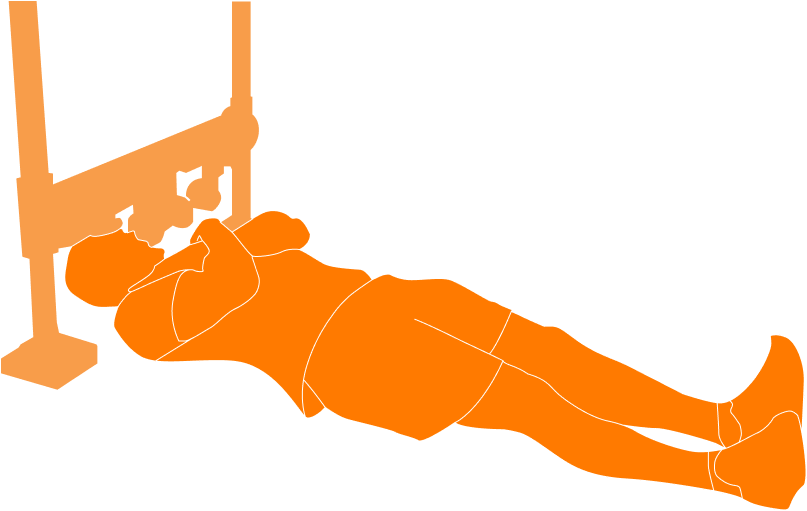 |
| Neck Extension | Prone |
| 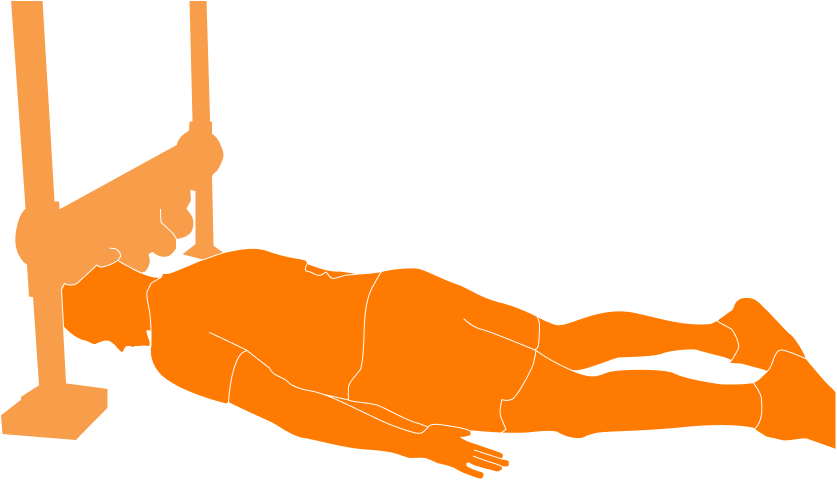 |
| Lateral Flexion | Side lying |
| 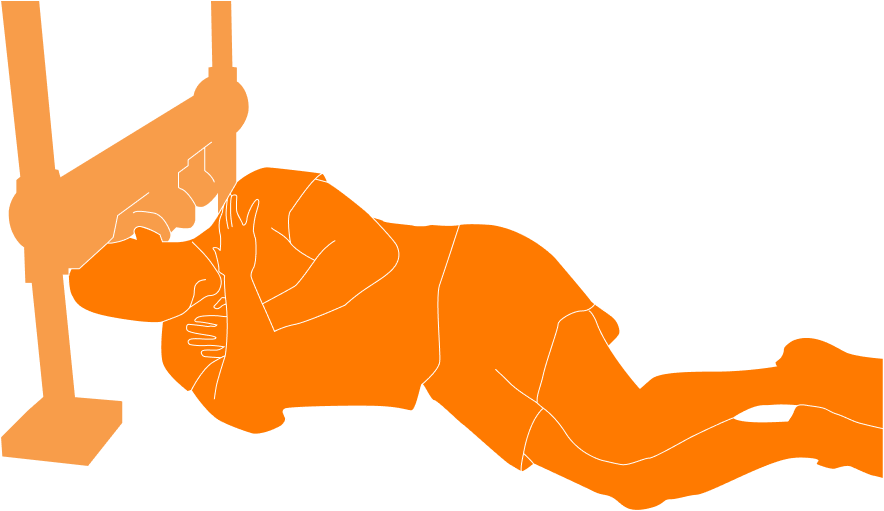 |
Testing Overview
Those administering the NCST are encouraged to adopt the same standardized cueing for each athlete:
- “Engage” (touch the paddle)
- “Build” (slowly increase force production)
- “Go!” (maximally push for 3 seconds)
Two trials are typically collected per direction, with rest in between.
All tests begin with a structured warm-up, typically including banded step-outs across all directions to activate the primary neck musculature. Athletes also perform submaximal efforts at 50% and 75% intensity to aid familiarization and prepare for maximal effort.
During testing, a ramp-style protocol is used, encouraging athletes to progressively build tension over the first few seconds of the trial. If an athlete reports neck pain at any point, testing should be stopped immediately, and they should be referred to a medical provider to assess for potential contraindications.
Testing has helped drive athlete buy-in and engagement – particularly after they have seen the data and how we subsequently individualize programming for them as a result.
Testing has helped drive athlete buy-in and engagement – particularly after they have seen the data and how we subsequently individualize programming for them as a result. Once they have gone through training, they can feel the difference in competition.
What Strong Looks Like
Internal data analysis has informed initial guidelines to support programming decisions. These values may differ from published norms, reflecting the realities of testing athletes during regular training. Emerging trends highlight sport- and training-specific demands that can help tailor interventions to individual needs. The simplified ranges below represent target averages for male and female athletes across all weight classes.
Target Benchmarks
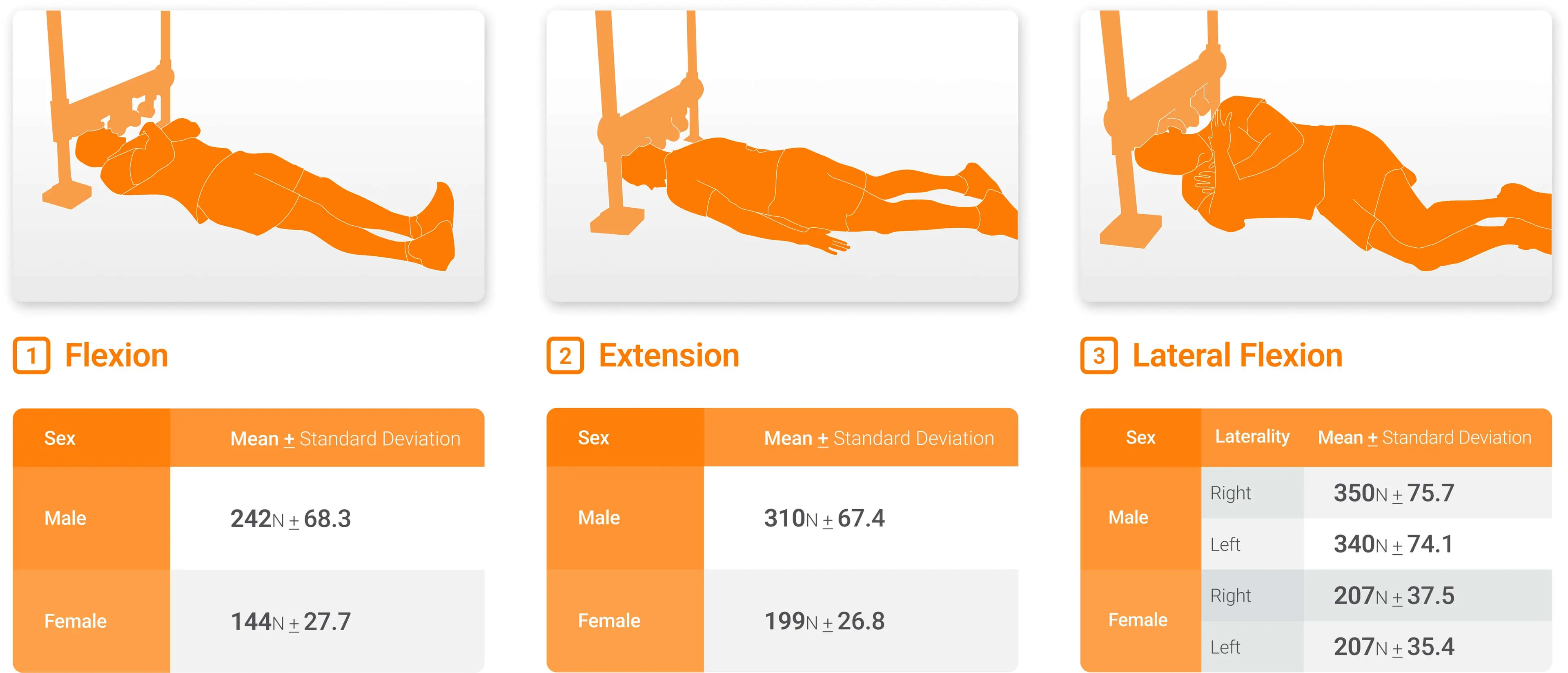
Benchmark values established for each NCST by the UFC Performance Institute.
These forces not only highlight differences in target ranges between male and female MMA athletes but also indicate the extent to which this quality can vary. Variety is likely driven by multiple factors, including the following:
- Neck Training History: A low training age will highlight lower force capability.
- Injury History: Current or previous injuries affect force output.
- Test Position: Neck flexion is the least trained test position and therefore has the lowest force production values.
- Sport Specificity: Lateral flexors are used most often in combat sports, making them stronger than in other sporting codes.
- Weight Class: Relative strength is important due to greater impact forces received at heavier weight classes.
In addition to peak forces across muscle actions in the NCST, strength ratio comparisons also help inform training decisions.
| Comparison | Ratio (Male) | Ratio (Female) |
| Flexion to Extension | 0.8:1 | 0.7:1 |
| Extension to Lateral Flexion | 0.8:1 | 0.9:1 |
| Flexion to Lateral Flexion | 0.7:1 | 0.65:1 |
| Left to Right | 1:1 | 1:1 |
Data collected from the UFC Performance Institute, 2025.
These ratios reflect the unique demands of MMA, where athletes rely heavily on lateral flexion strength during grappling and takedown control. The standard 1:1 flexion-to-lateral flexion ratio may not apply in this context and should be interpreted cautiously when compared to non-combat athletes. Instead, UFC benchmarks reflect the true functional demands of the sport.
Frequency of Testing
Testing is strategically scheduled based on the MMA calendar. Athletes go through different training phases depending on where they are in their fight preparation:
- Return to Training (Post-Fight): Often following a rest period, during which body composition and strength may have regressed.
- Off-Camp Block: A critical window of general and specific physical preparation.
- Fight Camp: Tactical and technical focus ramps up, and strength work becomes more refined.
We aim to test at the start of an off-camp block and again 8-12 weeks later, depending on the length of time before their next scheduled fight.
We aim to test at the start of an off-camp block and again 8-12 weeks later, depending on the length of time before the next scheduled fight. This allows us to monitor changes, adjust programming and move athletes through our neck strength matrix.
Making Programming Decisions
The data helps to identify targeted interventions and opens conversations between coaches and athletes. Once we identify an athlete’s weakest test (flexion, extension or lateral) and the associated ratios, we program accordingly. The key metrics we monitor include the following:
- Absolute strength (N)
- Relative strength (N/kg)
- Ratios between different NCST assessments (e.g., flexion:extension)
We progress an athlete through our strength matrix based on their ability to demonstrate adequate strength levels within established strength ratios. In other words, progression toward fast, dynamic and reactive strength only takes place once the athlete can demonstrate their ability to stabilize the neck musculature under loaded conditions.
Using the Neck Matrix to Guide Progression
To help guide development, the UFC Performance Institute created “The Neck Matrix,” which classifies exercises and prescriptions based on the type of strength expression required.
The UFC Performance Institute Neck Matrix
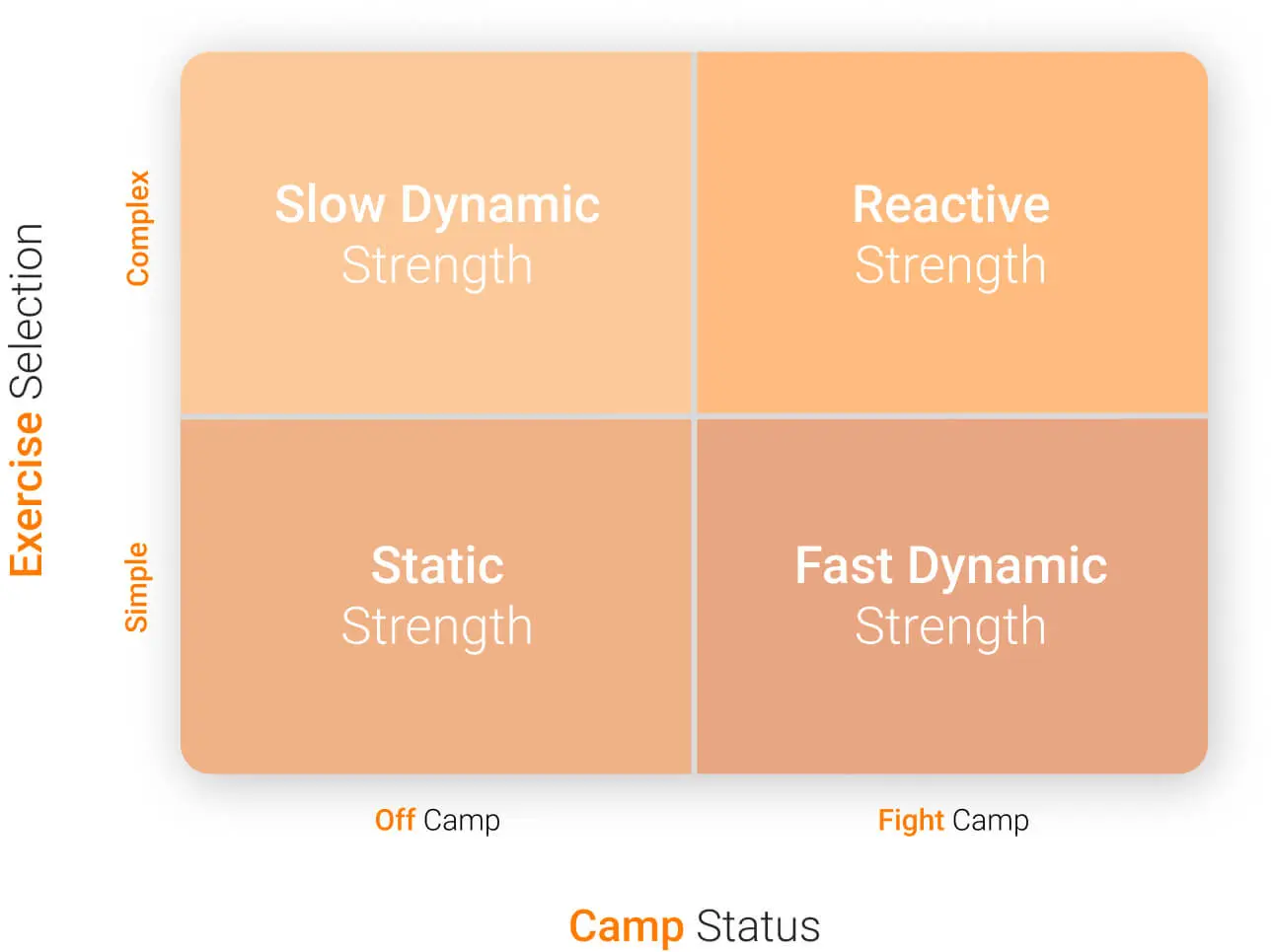
Build strength, then learn to express it faster. This principle is fundamental to performance enhancement strategies across sport.
Build strength, then learn to express it faster. This principle is fundamental to performance enhancement strategies across sport.
| Phase | Description | Purpose | Training Examples |
| Static | Isometric effort | Postural maintenance and absolute force | ForceFrame and band isometrics |
| Slow Dynamic | Isotonic, heavily loaded movement | Hypertrophy and absolute force | Cable stacks and tempo harness work |
| Fast Dynamic | Fast, moderately loaded movement | Rate of force development and “stiffness” | Keiser neck rotations and flywheel neck work |
| Reactive | Unpredictable, high-speed contractions | Impulse, “stiffness” and reactive load tolerance | Bungee pulls and partner reaction drills |
Practical Logistics and Coaching Integration
Integrating neck assessment and training can be simplified into three basic steps:
- Coordinate with coaches to pull athletes off the mat at planned times for testing.
- Slot neck training between primary lifts (e.g., push–pull–neck tri-sets) or as part of the activation series prior to a lift or a training session.
- Utilize scalable tools such as bands, manual resistance, cost-effective harnesses and technology-enabled tools like Training Mode.
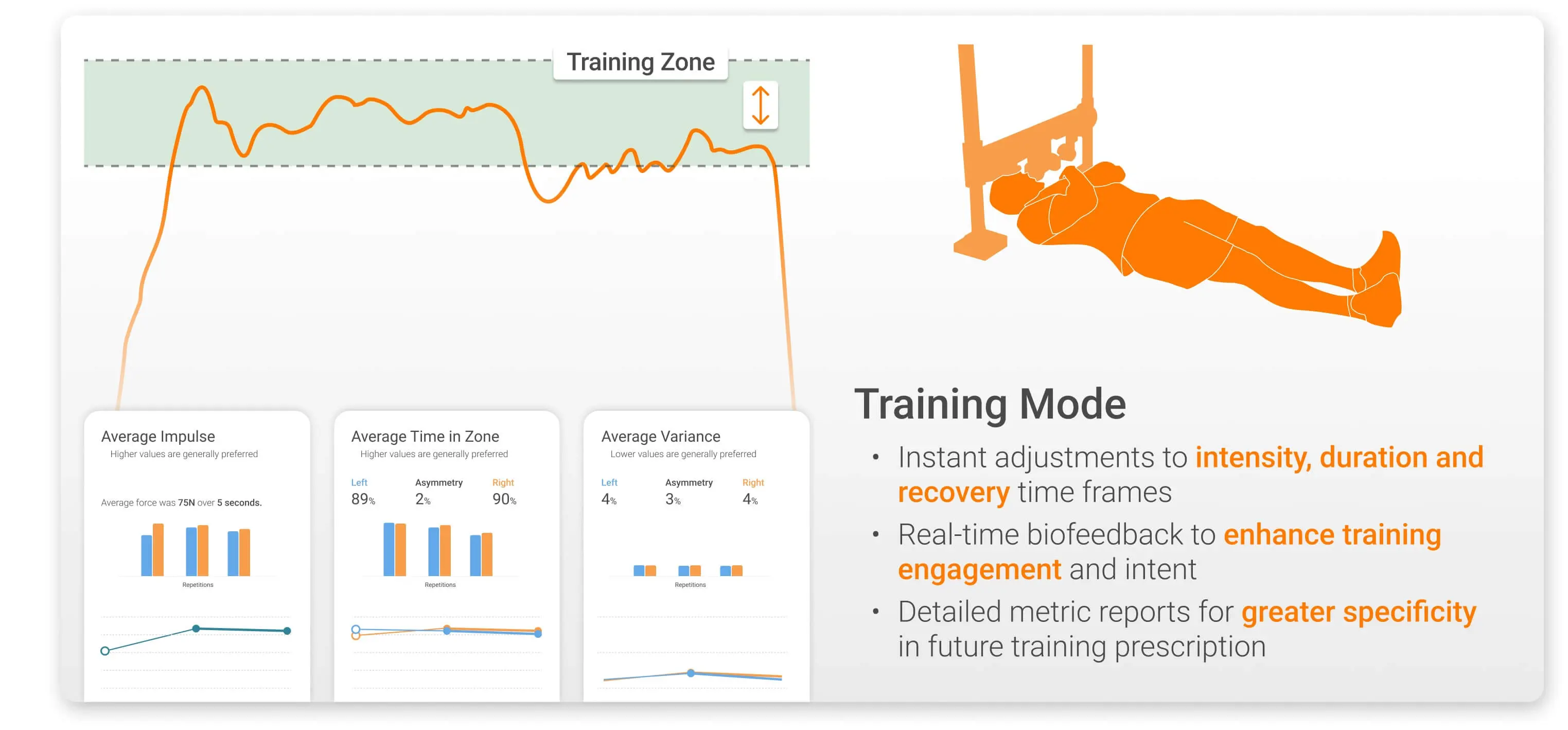
Neck performance training and monitoring is about using the data to program better, progress smarter and mitigate risk.
Neck performance training and monitoring is about using the data to program better, progress smarter and mitigate risk. Once those priorities are set, practitioners can let their creativity help execute the interventions.
Final Thoughts
Neck coupling strength testing using ForceFrame is a key component of athlete profiling at the UFC Performance Institute. The process creates a clear feedback loop – testing identifies deficits that are targeted in training, and retesting determines the effectiveness of the interventions used.
For practitioners in high-contact or collision sports, this provides a simple, effective framework for integrating objective strength testing into performance and injury-prevention programs. By applying the same principles, teams can better individualize training, reduce injury risk and track meaningful adaptations over time.
If you would like to learn more about the latest ForceFrame Max updates or how ForceFrame can help streamline and expand your clinic’s testing capabilities, get in touch with our team.
